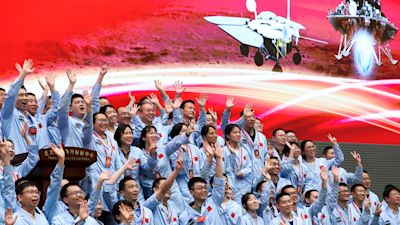China lands on Mars for first time in major advance for its space ambitions

China has landed a rover craft on Mars for the first time in a major boost to the country's space ambitions.
The Zhurong rover, named after the Chinese god of fire, landed on Saturday in a feat far more difficult than a moon landing.
The Chinese vehicle will stay in the lander for a few days before rolling down a ramp to explore the planet alongside an American rover that arrived in February.
The official Xinhua News Agency reported the landing, saying: "China has left a footprint on Mars for the first time, an important step for our country’s space exploration."
Who else has landed on Mars?
China is only the second country to successfully land on the red plant.
The US has had nine successful landings on Mars since 1976.
The Soviet Union landed on the planet in 1971, but the mission failed after the craft stopped transmitting information soon after touchdown.
A rover and a tiny helicopter from the American landing in February are currently exploring Mars.
Nasa expects the rover to collect its first sample in July, for return to Earth in a decade.
How did China land a rover on Mars?
China has landed on the moon before, but landing on Mars is a much more difficult undertaking.
Spacecraft use shields for protection from the searing heat of entering the Martian atmosphere, and use both retro-rockets and parachutes to slow down enough to prevent a crash landing.
The parachutes and rockets must be deployed at precise times to land at the designated spot.
Only mini-retro rockets are required for a moon landing, and parachutes alone are sufficient for returning to Earth.
Xinhua said the entry capsule entered the Martian atmosphere at an altitude of 80 miles, initiating what it called "the riskiest phase of the whole mission".
A 200 square metre (2,150sq ft) parachute was deployed and later jettisoned, and then a retro-rocket was fired to slow the speed of the craft to almost zero, Xinhua said.
The craft hovered about 330ft above the surface to identify obstacles before touching down on four buffer legs.
Touchdown was at 7.18am Beijing time (12.18am BST), although more than an hour passed before ground controllers could confirm the landing was a success, Xinhua said.
The rover had to open its solar panels and antenna, and then it took more than 17 minutes for its signals to traverse the distance between Mars and Earth.
What are China's space ambitions?
China’s space programme proceeded in a more cautious manner than the US and the Soviet Union during the height of their space race.
In recent years, however, the country has accelerated its space explorations, with president Xi Jinping hailing the Mars landing as "an important step in our country’s interplanetary exploration journey, realising the leap from Earth-moon to the planetary system and leaving the mark of the Chinese on Mars for the first time".
The launch of the main module for China’s space station in April is the first of 11 planned missions to build and provision the station and send up a three-person crew by the end of next year.
While the module was successfully launched, the uncontrolled return to Earth of the rocket drew international criticism including from Nasa administrator Bill Nelson.
China has said it wants to land people on the moon and possibly build a scientific base there. No timeline has been released for these projects. A space plane is also reportedly under development.